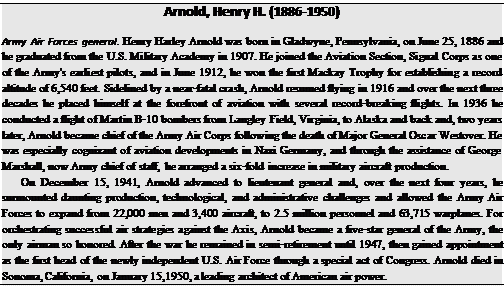1931
JANUARY 9 In Washington, D. C., Army Chief of Staff Douglas MacArthur and Chief of Naval Operations William V. Pratt agree to allow the Army Air Corps to monopolize coastal defenses, while the Navy remains free to concentrate on carrier aviation and mobile air operations at sea.
FEBRUARY 15 At Selfridge Field, Michigan, the first nighttime deployment of aircraft unfolds when 19 planes take off, navigate nocturnally, then land safely at Bolling Field, Washington, D. C.
May 9 The War Department approves
reproduction of the A-2 leather flying jacket as stand issue for aviators.
May 21—30 Brigadier General Benjamin D. Foulois directs a massive aerial training exercise, involving 667 aircraft and 1,400 crew members, as it commences across the nation. Every manner of aerial operation, including pursuit, bombardment, and observation, is successfully conducted; Foulois receives the Mackay Trophy for directing these ambitious maneuvers.
MAY 27 At Langley Field, Virginia, Army and NACA personnel construct the nation’s first full-scale wind tunnel for testing full-size aircraft.
July 15-31 Maxwell Field, Montgomery, Alabama, becomes the new site of the Air Corps Tactical School. It becomes a hotbed of new air power theories throughout the ensuing decade. Foremost among them is the notion oflong-range, daylight strategic missions employing
precision bombing techniques. This becomes the backbone of American aerial strategy during World War II.
July 29 At Tokyo, Japan, Colonel Charles Lindbergh, accompanied by his wife, flies a Lockheed Sirius in from New York in one of the earliest transpacific flights.
AUGUST 11 At Maxwell Field, Alabama, Major John Curry gains appointment as commander of the Air Corps Tactical School.
September 4 A Laird Racer flown by Lieutenant James H. Doolittle wins the first Bendix Transcontinental Race by flying from Los Angeles, California, to Cleveland, Ohio, in 9 hours and 10 minutes. He then refuels and continues on to Newark, New Jersey,
completing a coast-to-coast flight in only 11 hours and 16 minutes. Doolittle refuels again, returns to Cleveland to claim his trophy, then flies into St. Louis, Missouri, and home.
NOVEMBER 1 At Randolph Field, Texas, the aviation school enrolls its first class of 198 students, which includes members from West Point, the enlisted ranks, and civilian candidates.
DECEMBER 18 Over Hawaii, a glider flown by Lieutenant William A. Cooke sets an airborne record of 21 hours, 34 minutes, and 15 seconds.
 |
December 19 In Washington, D. C., Major General Benjamin D. Foulois gains appointment as commander of the Army Air Corps.










